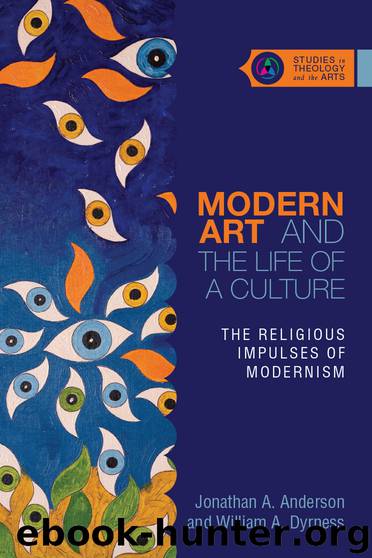Modern Art and the Life of a Culture by Jonathan A. Anderson & William A. Dyrness

Author:Jonathan A. Anderson & William A. Dyrness [Anderson, Jonathan A.]
Language: eng
Format: epub
ISBN: 9780830899975
Publisher: InterVarsity Press
Published: 2016-05-18T16:00:00+00:00
Figure 6.3. Marsden Hartley, The Dark Mountain, No. 2, 1909
On February 17, 1913, the famous Armory Show opened in New York (closing March 15, though parts of the exhibition traveled later to Boston and Chicago), offering a vivid example of the tensions being played out in American art. Though it served as a turning point in the development of an American voice, its characterization as a “foreign invasion” and a secularizing influence has often been exaggerated. While it exposed the broader public to several major European artists, and in the process set off a lively discussion about art and its role in modern life, it certainly did not mark the complete triumph of European modernism, nor did it “cut short a developing tradition of American realism.”79
Arguably the influence of Europe, especially of France, had been constant since the middle of the previous century. Many major artists spent time in London and later in Paris, and major galleries like Stieglitz’s Gallery 291 had been showing important French artists for some time before the Armory Show. Moreover, a generous selection of American artists (like William Glackens and especially Ryder) was included in that 1913 exhibition. The review of Charles Caffin, appearing in the New York American on March 10, 1913, illustrates the contradictory responses the show elicited.80 On the one hand, Caffin insisted that the exhibition illustrated the way “the old ideas of religion have been gradually supplanted by the new idea of the religion of science.” Yet he also goes on to note that around the core of French masters, Albert Pinkham Ryder was honored with ten pictures in the central gallery, more than any other American painter. As Caffin says of Ryder, “in his unobtrusive sincerity he, in fact, anticipated that abstract expression toward which painting is returning and may almost be said to take his place as an old master in the modern movement.” No doubt Caffin was right about this, but it is hard to see how Ryder (or many of the French masters, for that matter) could represent the idea of the “religion of science.” Ryder had completely withdrawn from public view by this point, but he was still alive to celebrate his triumph. One of the show’s organizers, Arthur Davies, persuaded Ryder to visit the Armory Show, and he led the old man on his arm through the gallery with Ryder’s paintings. Davies reported that he “grunted a few times and nodded his head.” The Reverend was content.
Download
This site does not store any files on its server. We only index and link to content provided by other sites. Please contact the content providers to delete copyright contents if any and email us, we'll remove relevant links or contents immediately.
The 5 Love Languages: The Secret to Love That Lasts by Gary Chapman(8481)
The Space Between by Michelle L. Teichman(6080)
Assassin’s Fate by Robin Hobb(5229)
Wiseguy by Nicholas Pileggi(4582)
Everything Happens for a Reason by Kate Bowler(4062)
Gerald's Game by Stephen King(3913)
A Simplified Life by Emily Ley(3565)
The Power of Positive Thinking by Norman Vincent Peale(3443)
Pillow Thoughts by Courtney Peppernell(3382)
Resisting Happiness by Matthew Kelly(2882)
Girl, Wash Your Face by Rachel Hollis(2819)
Being Aware of Being Aware by Rupert Spira(2702)
Name Book, The: Over 10,000 Names--Their Meanings, Origins, and Spiritual Significance by Astoria Dorothy(2488)
Real Sex by Lauren F. Winner(2467)
More Language of Letting Go: 366 New Daily Meditations by Melody Beattie(2436)
The Holy Spirit by Billy Graham(2408)
Fast Facts on Defending Your Faith by John Ankerberg & John Weldon(2387)
Victory over the Darkness by Neil T. Anderson(2384)
The Secret Power of Speaking God's Word by Joyce Meyer(2248)
